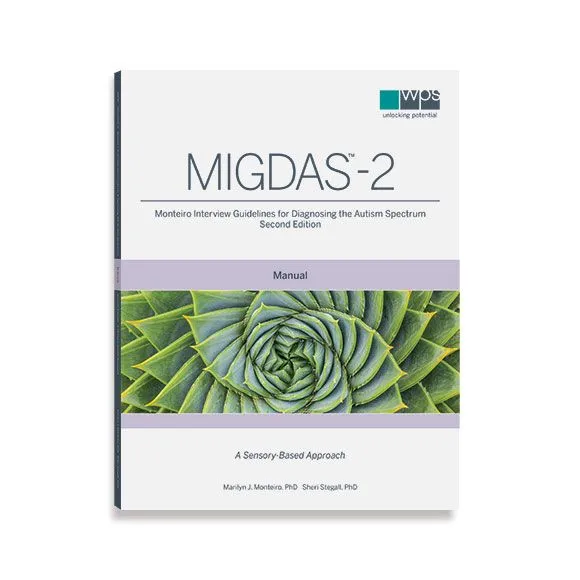
Monteiro Interview Guidelines for Diagnosing Autism Spectrum, Second Edition [MIGDAS-2]
For: Provides evaluators with an efficient method of systematically gathering and organising the information needed to diagnose autism spectrum disorder (ASD) in children, adolescents, and adult
Ages: Toddlers, children, adolescents, and adults
Format: Paper-and-Pencil
Length: Varies; 30 to 90 minutes, depending on format
Scoring: Hand Scored
Scores: Qualitative description of the student covering three areas: Language and Communication, Social Relationships and Emotional Responses, and Sensory Use and Interests
Published: 2018
Printed Manuals
Click to browse products
Printed Kits
Click to browse products
Printed Forms & Handscoring Materials
Test forms, response booklets and scoring reference manuals.
MIGDAS-2 Manual
MIGDAS-2 Online Manual
MIGDAS-2 Kit
MIGDAS-2 Diagnostic Interview for Adults with Verbal Fluency Form (Pack of 5)
MIGDAS-2 Diagnostic Interview for Children and Adolescents with Verbal Fluency Form (Pack of 5)
MIGDAS-2 Diagnostic Interview for Individuals with Limited to No Verbal Fluency Form (Pack of 5)
MIGDAS-2 Parent/Caregiver Questionnaire (Pack of 5)
MIGDAS-2 Teacher Questionnaire (Pack of 5)
Sample Reports
Author
Marilyn J. Monteiro, PhD, and Sheri Stegall, PhD
Description
The Monteiro Interview Guidelines for Diagnosing the Autism Spectrum, Second Edition is a sensory-based process for gathering and organizing the qualitative information needed to diagnose autism in children, adolescents, and adults. The process includes guidelines for gathering information from parents/caregivers and teachers, and for conducting a sensory-based interview with the individual being evaluated. The end result is a comprehensive behavioural profile that describes the individual’s distinct way of relating to the world, supplementing assessment scores and informing diagnosis and treatment planning. The MIGDAS-2 process is designed to facilitate writing a narrative evaluation report and providing diagnostic feedback using language that is easily understood by parents and others involved in the individual’s care.
Key Features of the MIGDAS-2 Assessment Process
- Interactive interview techniques: The MIGDAS-2 provides detailed, concrete guidelines for conducting interactive diagnostic interviews with children, adolescents, and adults suspected of having ASD.
- Parent/caregiver and teacher participation: The MIGDAS-2 provides structured guidelines for obtaining key information from parents/caregivers and teachers about the individual’s behaviour in home and school settings.
- Comprehensive qualitative information: The MIGDAS-2 is a unique evaluation tool that guides the evaluator to make a diagnosis based on direct interactions with the individual being evaluated and the individual’s parents/caregivers and teachers.
- Sensory-based approach: Emphasizing the use of sensory materials and encouraging discussion of areas of high interest to the individual, the MIGDAS-2 process provides a system for evaluators to gather distinctive examples of behaviour patterns often seen in individuals with ASD.
The MIGDAS-2 was developed as an outgrowth of extensive diagnostic work with individuals on the autism spectrum, as well as their families and teachers, and considerable collaboration with autism evaluation teams in public and private schools. The MIGDAS-2 process provides an organized, systematic way to elicit and document an individualized behavioural profile descriptive of the singular presentation of ASD in order to better inform autism diagnosis and treatment planning.
The MIGDAS-2 can be used by independent evaluators and evaluation teams, and it is ideally suited for a variety of settings, including private practices, schools, and hospitals. Because the MIGDAS-2 process integrates the multiple sources of information that must be considered when diagnosing ASD, it helps those involved in the evaluation process better understand the way in which autism spectrum differences specifically affect the individual being evaluated. The sensory-based diagnostic interview allows for an authentic assessment experience for the child, adolescent, or adult being evaluated. The qualitative behavioural profile obtained through use of the MIGDAS-2 also assists evaluators when considering comorbidity and making differential diagnoses, writing narrative evaluation reports, and providing diagnostic feedback to participants in the evaluation process.
The MIGDAS-2 includes five evaluation protocols: Parent/Caregiver Questionnaire, Teacher Questionnaire, Diagnostic Interview for Individuals With Limited to No Verbal Fluency, Diagnostic Interview for Children and Adolescents With Verbal Fluency, and Diagnostic Interview for Adults With Verbal Fluency.
The Parent/Caregiver Questionnaire and the Teacher Questionnaire provide detailed sets of questions designed to gather a comprehensive narrative about the individual being evaluated from the point of view of his or her parents/caregivers and/or teachers. The questionnaires can be used to facilitate an in-person interview or can be completed independently by having parents/caregivers or teachers write their responses directly on the questionnaire.
The Diagnostic Interview protocols are the cornerstone of the MIGDAS-2 assessment process. These protocols guide evaluators through the process of collecting and documenting samples of the individual’s behaviour in the three key areas of development that are affected in ASD: Sensory Use and Interests, Language and Communication, and Social Relationships and Emotional Responses.
The Diagnostic Interview for Individuals With Limited to No Verbal Fluency is designed for use with individuals who have not yet acquired the use of functional language. It is suitable for use with young children (i.e., preschool-aged children and toddlers who are able to engage in sensory-based play), as well as with older children, adolescents, and adults who display limited language and accompanying intellectual impairment.
The Diagnostic Interview for Children and Adolescents With Verbal Fluency is designed for use with children and adolescents who use language in a fluent capacity or who have acquired language but whose fluency is still emerging (i.e., language is not yet used with full fluency across settings or topics). It is appropriate for use with children as young as preschool age as well as with older children and adolescents.
The Diagnostic Interview for Adults With Verbal Fluency is designed for use with adults who have acquired language skills and use language in a fluent capacity. It is also appropriate for use with verbally fluent adolescents transitioning to adulthood. The interview is structured so that the evaluator has the option of including the individual’s adult partner or parents/caregivers in the session.
The MIGDAS-2 interviews require the use of common, sensory-based toys and materials (not included in the Kit purchase). The use of these materials and suggestions for building a sensory-based materials kit are described in the MIGDAS-2 Manual. Click here for more detailed descriptions of sensory-based materials and suggestions for where to obtain such materials.
NB: Prices are in Australian dollars inclusive of GST. NZ customers need to log in to view ex-GST prices.
MIGDAS-2 author Marilyn Monteiro, PhD, talks about her passion: improving the lives of those with autism spectrum brain style differences.
To watch the two-hour free MIGDAS-2 webinar simply click play below:



